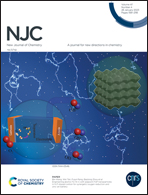Incorporation of superamphiphobic and slippery patterned materials for water collection inspired by beetle, cactus, and Nepenthes†
Abstract
Inspired by the natural creatures of beetle, cactus spines, and Nepenthes with superior water transportation and water collection ability, a novel patterned aluminum surface integrated superamphiphobic and slippery surface was designed for highly-efficient water collection. A wedge-shaped slippery pattern with hydrophilic lubricating oil was constructed on a superamphiphobic surface. On the one hand, a slippery surface efficiently captures fog drops because of its strong water affinity. Furthermore, it also showed high water transportation capability arising from low adhesion. Moreover, the specially designed wedge-shaped structure produced a Laplace pressure gradient that fast drove water drops away. Water drops were continuously self-driven and moved from superamphiphobic region to the slippery region. The finally patterned surface achieved a very large water collection rate (WCR) of 28.5 mg min−1 cm−2, which was 4 and 2 times larger than that on uniform superamphiphobic and slippery surfaces. Different from the normally designed superhydrophobic–superhydrophilic/hydrophilic pattern with the easy pollution problem, this patterned surface showed very excellent stability owing to its superior anti-pollution ability and special structure design, which endowed the surface with superior recyclability for water collection. The patterned surface also repeatedly collected acid and alkali fog with WCR values of 26.2 and 27.2 mg min−1 cm−2, respectively.



 Please wait while we load your content...
Please wait while we load your content...